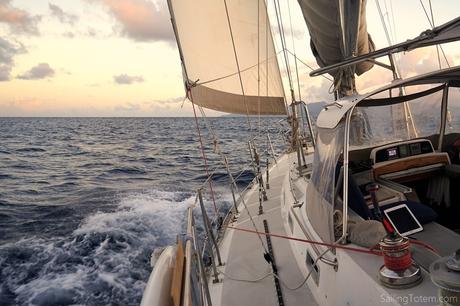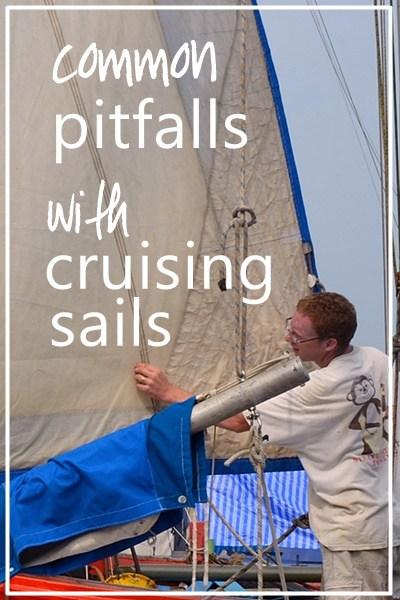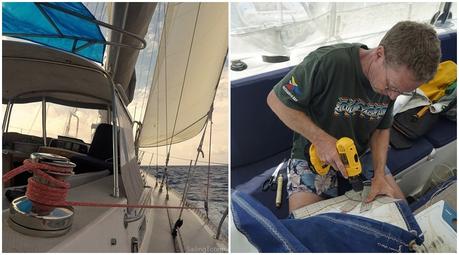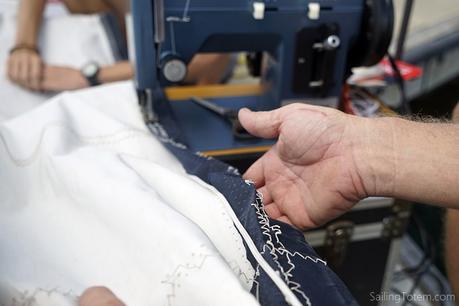
Jamie periodically shares his expertise in a technical article: here he reviews typical problems cruisers experience with their sails, and how to address them. For more from the wells of this cruising sailmaker, see tagged posts on the topic.
Way, way back when I was designing sails for crazy people that sailed around the world in the Whitbread, BOC, and Vendee Globe races, the sail inventory budgets were dazzling! A maxi-boat (about 82’ long) mainsail in the 1989-90 Whitbread Race could be $35,000. Racing around the globe competitively required at least 4 mainsails. Add 25-ish headsails and even more spinnakers and you can imagine why sailmakers loved long distance races.
That boom went bust when the Volvo Ocean Race (formerly Whitbread Round the World Race) organizers limited the entire sail inventory to just 17 sails. Millions of sailmakers weep for the loss. Porsche dealers and Rolex merchants report lackluster earnings because sailmakers stopped comin’ ‘round.
There is a glimmering benefit to all of this. More time for sailmakers and cruising sailors to make better cruising sails. Sailmakers will laugh. Woven Dacron sails shimmer like tin, not gold. Cruising sailors will either malign sailmakers for not listening to them and then delivering a product that’s unimproved in 50 years; or worship their sailmaker because by-golly they make ‘em like the good ‘ol days, with leather at the corners!
New cruising rags take riches that are too little

Sailor: I hear you’re a sailmaker. Can you look at my main? It has a small tear.
(10 minutes later)
Me: You’re right, it is a tear.
Sailor: Hey! Why are you tearing it further?
Me: Like tissue paper. Rotten sailcloth. You need a new sail.
Sailor: What? How can that be, my sails are only 3 years old?
Me: Oh, in that case we should also check your headsail for UV damage.
Sailor: WHAT!?!?
Sailmakers aren’t trained to gracefully deliver bad news. The emotional toll is terrible, even before Sailor stumbles onto the worst part. They’re at a remote paradise with bad sails and no way to replace them. Sailor weeps for the loss. I’ve had this scenario play out many times, including a mainsail that was just two years old. Moving forward, this cruising sailmaker presents common problems and solutions for better cruising sails meant to go the distance.

The dream… champagne sailing! The reality… repairs in exotic locations. Fixing a new friend’s sail in the Bahamas
(Note: sailcloth is a really big topic. Laminated sailcloth has a place on some cruising boats, but consequences like mildew and delamination make it a poor choice for many. Therefore, my focus is on woven cloth problems.)
Problem: High aspect sailcloth in sails bound for the tropics
Fibers make warp and fill yarns and woven to make sailcloth. High aspect sailcloth has many more fill direction fibers than the warp fibers. Logically the sail designer pairs high aspect cloth and high aspect sail (tall and narrow) to best manage sail loads. This is fine in temperate regions and seasonal sailing; it’s a serious flaw when cruising the tropics.
UV degrades tensile strength of exposed fibers. The outer fiber layer of a big yarn protects the inner fibers like sunscreen. High aspect warp yarns are tiny, and degrade entirely. This is how the cloth can fail in 2 to 4 years of active tropical sailing. Low aspect sailcloth is a better choice, even on a high aspect rig. Of course, always cover the sail when not in use.
Problem: Underbuilt sails
Sailcloth manufacturers provide recommendations to match cloth weight to sail size and type. Fixed calculations don’t account for context, like the type of sailing to be done, but that’s where the conflicted sailmaker comes in. Conflicted because when a situation warrants heavier Dacron or woven hybrid sailcloth, the cost goes up, followed by sail price that appears less competitive. Underbuilt sails stretch and distort easily, and are more susceptible to UV degradation. Stronger sails cost more, last longer with more reliability when going remote.
There are three ways to do this. One is simply higher weight sailcloth. A better method for boats over 40 feet, roughly, is adding a 2-ply leech. This puts more Dacron only along the leech of the sail where loads are highest. Last is woven hybrid cloth the combines Dacron and Dyneema/Spectra fibers, such as Dimension Polyant Hydranet. This is stronger, lower stretch, and lighter than conventional Dacron – with a premium price. Rags from riches.

Not underbuilt! Totem underway to Colombia
Problem: Low grade Dacron
Dacron is a Dupont brand name that has come to colloquially mean Polyester fiber woven sailcloth. A point murkier than bright white Dacron: Polyester fibers in sailcloth come in different grades. Quality brands such as Marblehead by Challenge Sailcloth and AP Blade by Dimension Polyant use high tenacity fibers that are stronger, lower stretch, and more expensive. Economy Dacron may suit casual sailing needs just fine, but come up short on long distance sails.
Problem: Headsail size
Multiple headsails sized for different conditions would be nice, but limited storage and more work with shorthanded sail changes makes them impractical. Instead, many full-time cruisers have one or two headsails, plus staysail or storm jib. The trick to this compromise is sizing the primary headsail well. Setting off to sail the world with a 135% or bigger genoa is probably not a good match. While it can be partially furled to reduce sail area, doing so creates a poorly shaped smaller sail with bias loading that can distort sailcloth. Consider conditions where you intend to sail and boat characteristics. I find that 100% to 120% range is enough without being too much for boats reaching out to multiple regions.
Problem: UV cover fail
Mainsail covers and UV covers on furling sails use materials resistant to UV degradation to protect sailcloth. They only work while securely sewn in place. Astoundingly, so many UV covers still get sewn on with thread that rots in the sun. UV resistant cloth and rot prone Polyester thread! Instead, Tenara thread does not rot and will last the life of the cover material.

Jamie repairs the UV strip for a friends headsail on the dock in Panama
Problem: Chafe
Chafe happens. Running with the main plastered into the rigging chafes at stitching and cloth. The pocket covering full length battens gets the worst of it. Rigid battens rubbing against shrouds and spreaders can cut through the pocket after only a few short passages. The solution is Polyester webbing sewn on top of the batten pockets. This provides many years of chafe protection, and help to dampen shock load to battens if they impact the shrouds after a gybe.
Problem: Survey says!
Having read many marine surveys, it’s fair to say that most marine surveyors don’t put much time or expertise into evaluating sails. Often sails get lumped together and reported as “good”. The transaction goes ahead and new owner brings sails into the local loft for inspection. A few days later a dispassionate sailmaker reports the mainsail is ready for the bin. The leech has serious UV damage from not being covered. The genoa may last another season or two if the UV cover gets replaced. New owner curses the surveyor. Sailmaker hands new owner a quote for new mainsail and genoa repair on the way out the door, mumbling something about being late for a regatta, before disappearing into an old reliable Volvo.
Wondering about your own sails? Jamie’s happy to share expertise one on one, just send us an email! Meanwhile, Totem is happily seeking out taco carts in La Paz, Mexico, and excited to sail north up Mexico’s Sea of Cortez this month.

